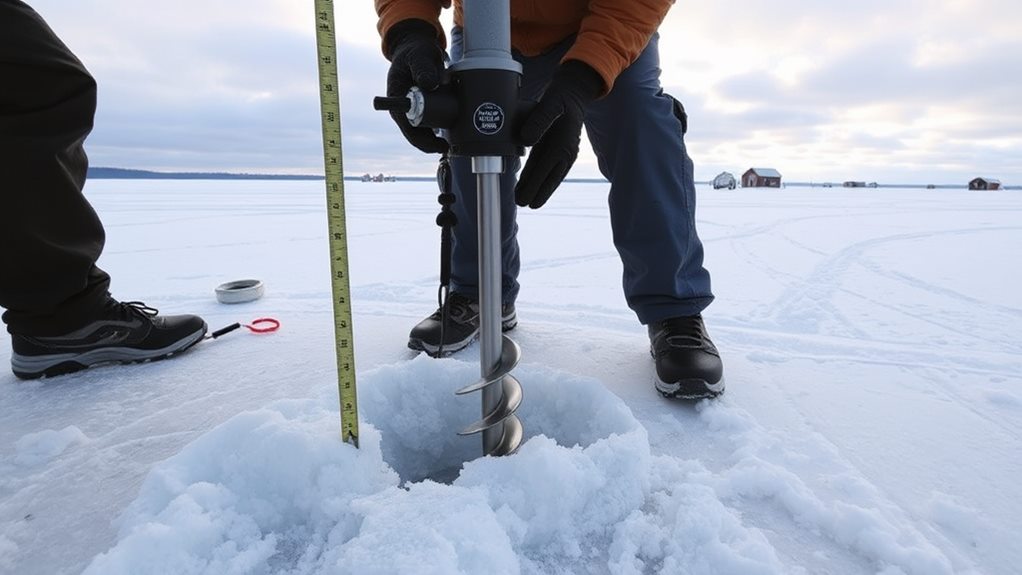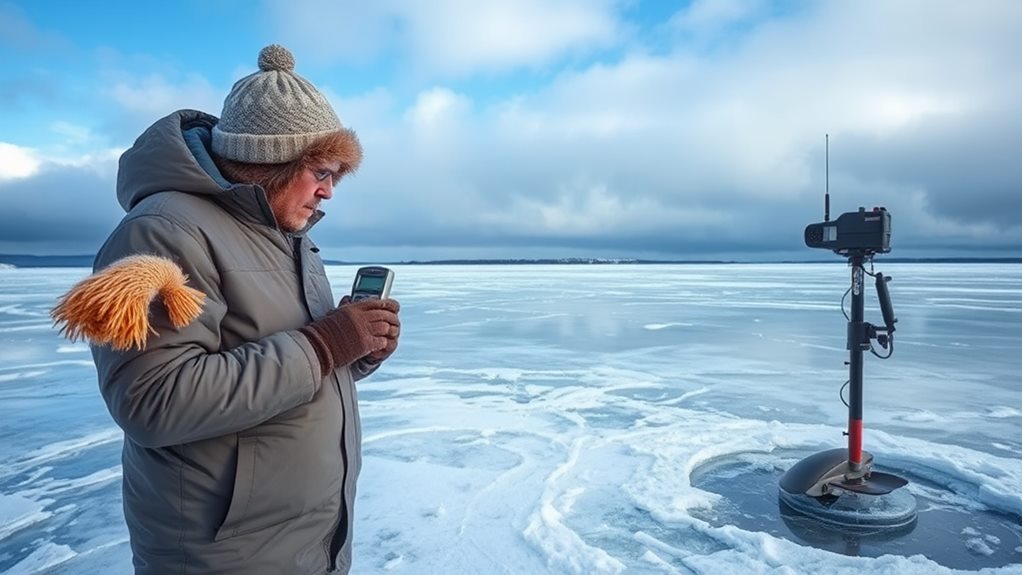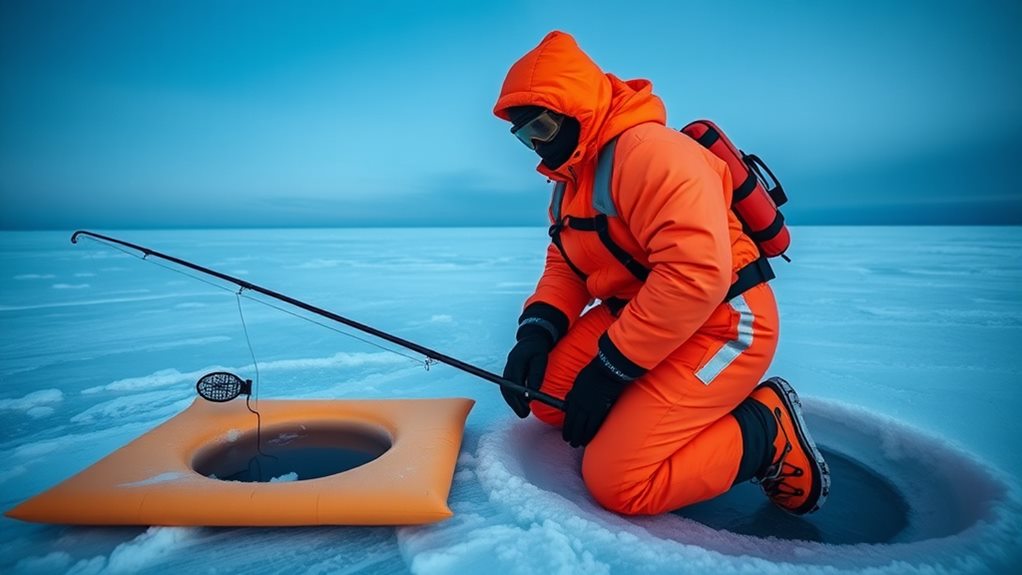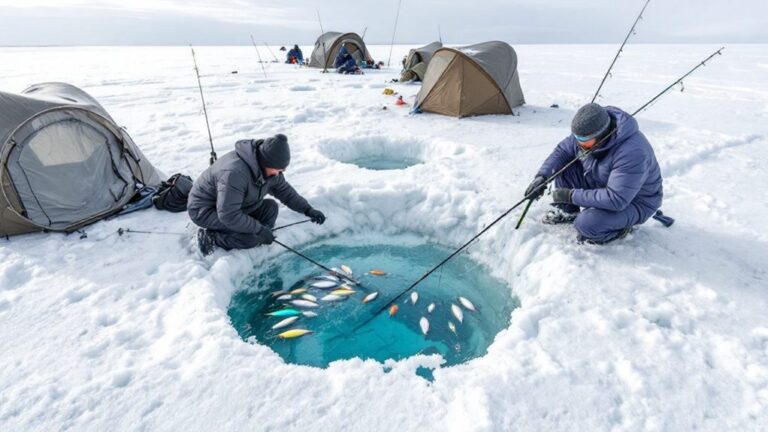Before heading out on your ice fishing adventure, you'll need to prioritize several vital safety measures. Always verify ice thickness (minimum 4 inches for walking), and bring proper safety gear including a personal flotation device, ice picks, and rescue rope. Keep a close eye on weather conditions and carry a fully-charged phone for emergencies. It's important to inform someone about your plans and expected return time, and remember to maintain regular communication with fishing companions. Never fish alone, and bring emergency supplies including a first aid kit and thermal blankets. These basics are just the tip of the iceberg when it comes to ice fishing safety.
Understanding Ice Thickness Requirements

Three vital measurements determine whether you're standing on safe ice or risking your life. When it comes to fundamental ice fishing safety, you'll need at least 4 inches of clear ice beneath your feet for safe walking and fishing activities.
It's a good idea to regularly test the thickness as you move across the frozen surface, since conditions can vary dramatically in different areas. Additionally, be aware that ice thickness can fluctuate due to factors such as temperature changes and water currents, which can create weak spots.
Always keep in mind the importance of safety considerations when planning your trip.
If you're planning to bring vehicles onto the ice, you'll need to be even more cautious. Snowmobiles and ATVs require 5 to 8 inches of solid ice, while small cars need 8 to 12 inches to stay safe. For medium-sized trucks, don't venture out unless you've confirmed at least 12 to 15 inches of thickness.
Remember these vital guidelines:
- Never step on ice less than 2 inches thick
- Check thickness every 150 feet as you move
- Don't assume the entire lake has uniform thickness
- Use proper tools to measure ice depth
Whether you're a beginner or experienced angler, understanding and respecting these ice thickness requirements isn't just about following rules—it's about ensuring you'll make it home safely after your fishing adventure.
Essential Safety Equipment
What's the most critical gear that could save your life while ice fishing? Let's break down the vital safety equipment you won't want to leave home without.
First and foremost, you'll need a personal flotation device (PFD). While you might think you're a strong swimmer, cold water can quickly drain your energy, and a PFD will keep you afloat if you break through the ice.
Ice picks or rescue claws are another must-have – they'll help you pull yourself out if you fall through, so keep them easily accessible on your outer clothing.
Before setting up your ice fishing spot, you'll want to test the ice thickness with a spud bar or chisel. Don't skip this step, as it's your first line of defense against dangerous ice conditions.
Additionally, pack a throw rope that's at least 50 feet long – it could be the lifeline that saves a fellow angler in trouble.
Round out your safety gear with a thorough first aid kit and emergency supplies, including flares. While you might think you'll never need these items, they're like insurance – it's better to have them and not need them than the other way around.
Weather and Environmental Monitoring

Staying alert to weather conditions can make the difference between a safe ice fishing trip and a dangerous situation. You'll need to monitor weather forecasts regularly and pay close attention to temperature changes, particularly when they rise above freezing, as this can compromise ice safety.
Keep in mind that areas near moving water, like river mouths and bridges, require extra caution due to thinner ice and unpredictable currents.
To guarantee your safety while ice fishing, consider these critical monitoring practices:
- Check local weather updates frequently, especially for incoming storms or significant wind changes that could affect ice conditions.
- Use GPS and mapping tools to mark safe routes and document areas with known hazards or weak ice thickness.
- Assess ice conditions throughout your trip, paying special attention after snowfall which can mask potential dangers.
Remember that ice conditions can change rapidly, so don't rely solely on previous experiences or other anglers' assessments.
When you're tracking weather patterns and maintaining awareness of your surroundings, you're taking crucial steps to protect yourself and others on the ice. Always trust your instincts – if conditions seem questionable, it's better to postpone your trip than risk your safety.
Emergency Response Plans
While monitoring conditions helps prevent emergencies, having a solid response plan can save your life when things go wrong. When it comes to ice fishing safety tips, you'll want to start by telling a family member or friend exactly where you're headed and when you plan to return – this simple step guarantees someone knows where to look if you don't check in.
Always carry a pair of ice picks and practice using them before you need them in an emergency. You'll also want to keep a signaling device, like a whistle, readily accessible on your outer clothing. These tools can make the difference between life and death if you fall through the ice.
Your emergency response plans should include regular check-ins with fishing companions and maintaining a working cell phone in a waterproof container. Before heading out, familiarize yourself with the nearest emergency access points and keep them marked on a map.
Vehicle Safety on Ice

On frozen lakes and ponds, vehicles pose one of the biggest safety risks for ice fishing enthusiasts. When planning your ice fishing adventure, it's vital to avoid driving vehicles onto ice whenever possible, as this practice leads to numerous accidents and drownings each year.
Instead, focus on vehicle safety on ice by parking on shore and using alternative methods to transport your gear. Before heading out, always assess ice conditions thoroughly, particularly near the shoreline where ice tends to be less stable.
You'll find it much safer to pack gear in a utility sled and walk to your fishing spot rather than risk driving on uncertain ice. If you absolutely must drive on ice, develop an emergency exit plan and share it with everyone in your group.
Here are fundamental vehicle safety guidelines to remember:
- Park your vehicle on solid ground at least 50 feet from the ice's edge
- Use a utility sled to transport your gear instead of driving onto the ice
- If driving is unavoidable, maintain significant distance between vehicles and have escape tools readily available
Communication and Location Tracking
Proper communication out on the ice serves as your lifeline during ice fishing expeditions. Before heading out, you'll want to share your detailed fishing plans with family or friends, including specific lake locations and your expected return time. This simple step guarantees someone knows where to find you if something goes wrong.
Modern GPS technology is your best friend for location tracking and ice safety. You can mark potential hazards, weak ice spots, and your favorite fishing holes with digital pins, making navigation much safer and more efficient.
Don't forget to keep your phone fully charged and verify cell service availability in your chosen fishing area beforehand.
When you're out with companions, establish a clear check-in protocol to maintain regular communication throughout your trip. It's like having a buddy system on ice – you'll want to know where everyone is and that they're safe.
Here's what to track:
- Your precise location on the lake
- Areas of dangerous or thin ice
- Distance from shore and access points
- Regular status updates with your group
- Emergency contact information
Personal Protection Measures

Personal safety equipment forms the vital foundation of every ice fishing expedition.
You'll need to prioritize wearing a personal flotation device at all times, as it's your primary defense against drowning if you break through the ice. A quality flotation suit serves double duty by keeping you both buoyant and warm, which is important for preventing hypothermia in harsh winter conditions.
Layer your clothing strategically, starting with thermal underwear and building up to insulated outerwear that allows you to move freely while staying protected.
Don't forget to keep important safety gear within easy reach – you never know when you might need it!
Here are three must-have items for your safety kit:
- Ice picks attached to your jacket with retractable cords, allowing for quick access if you need to pull yourself out of the water
- A loud whistle secured to your PFD for signaling help in emergency situations
- A waterproof first aid kit containing basic medical supplies and emergency warming materials
Remember to inspect all your safety equipment before each trip, ensuring everything's in working order.
After all, the best safety gear is only effective when it's properly maintained and readily accessible.
Setting Up Safe Fishing Spots
When selecting your fishing spot, thorough ice assessment becomes your critical first step for a secure setup. You'll want to verify that there's at least 4 inches of clear, safe ice before you even think about unloading your gear. Remember, it's better to spend extra time checking ice thickness than to risk falling through the ice.
During cold weather outings, you'll need to strategically choose your fishing spot by avoiding potentially dangerous areas. Stay away from moving water sources, such as streams or inlets, where ice tends to be thinner and more unpredictable.
Keep an eye out for visible warning signs like cracks or slushy patches, which often indicate weak spots you'll want to avoid. Smart anglers use GPS devices to mark and remember safe zones while steering clear of known hazard areas.
Don't forget to factor in environmental conditions – wind direction and temperature changes can affect ice stability throughout your fishing session. A spot that's safe in the morning might become risky by afternoon, so you'll want to maintain awareness of changing conditions.
When in doubt about a location's safety, it's always wise to move to a more reliable area.
Frequently Asked Questions
What Are 5 Safety Tips All Anglers Should Follow?
You'll need to test ice thickness first, bring a fishing buddy, carry ice picks and a whistle, check local conditions regularly, and wear layers with a PFD for safe and successful angling adventures.
What Should You Not Do When Ice Fishing?
You shouldn't venture onto thin ice under 4 inches, drink alcohol while fishing, go alone without a buddy, drive vehicles on ice less than 12 inches thick, or ignore changing weather conditions.
How to Ice Fish Safely?
You'll need 4+ inches of solid ice, safety gear like ice picks and a PFD, and a fishing buddy. Check ice thickness regularly with a spud bar and dress warmly in layers when ice fishing.
What Is the Risk of Ice Fishing?
You're risking falling through thin ice, hypothermia, and drowning while ice fishing. You'll also face dangers from unstable ice near streams, hidden cracks under snow, and increased risks if you're drinking alcohol.
Final Thoughts
Ice fishing can be an incredible winter adventure when you're properly prepared and safety-minded. By following these crucial guidelines for ice thickness, equipment, weather monitoring, and emergency planning, you'll be ready to enjoy this unique sport with confidence. Remember, it's always better to err on the side of caution – you can't catch fish if you don't stay safe. Take these precautions seriously, and you're set for an unforgettable experience on the ice.




